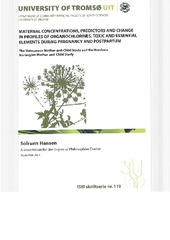| dc.description.abstract | Persistent toxic substances like organochlorines (OCs) and certain toxic metals have been or
are extensively used, and can be globally distributed by long-range transport. The fetus and
growing child are exposed via the placenta and breast milk and are vulnerable to their
negative health effects. Concentrations measured in maternal blood or breast milk are thus
potential indicators of risk for the next generation. Internal and external factors contribute to
the maternal body burden of these toxicants including: age, parity, lactation, diet, past and
current exposures, and the half-life of the contaminant in the body. Essential elements can
modify the gastrointestinal absorption of toxic elements and thereby influence the negative
impact of the latter. During the gestational and postpartum periods, remarkable physiological
adaptions occur, and such changes have the potential to affect the maternal blood levels of
persistent toxic substances and essential elements during these critical windows.<br>
The main objectives of this thesis research were to: investigate maternal concentrations of
OCs and non-essential (toxic) and essential elements in the context of a northern-southern
latitude perspective; identify exposure predictors: and investigate the influence of
physiological changes and related pregnancy adaptations during the gestational and
postpartum periods.<br>
The present work included pregnant and delivering women from two mother-and-child
studies from Northern Norway (participant subsets of 50 and 211) and two communities in
Southern Vietnam (total participants of 189), carried out respectively in 2007-09 and 2005. A
suite of selected OC contaminants were analyzed in both study groups, and 5 toxic and 5
essential elements were additionally analyzed in the Northern Norwegian group. For the
latter, changes in concentrations of all substances were investigated between three different
collection periods: during the 21 trimester, and at 3 days and 6 weeks postpartum.<br>
In the North Norwegian study, low maternal concentrations of both OCs and toxic elements,
and normal levels of essential elements, were generally observed. The Vietnamese study
demonstrated relatively high levels of p,p’-DDE and p,p’-DDT, among the highest globally
speaking and possibly reflecting recent or current use. In contrast, the concentrations of PCBs
were somewhat lower than those found among the Norwegian mothers.<br>
For the OCs, age (positive) and parity (negative) were strong predictors, with the latter being
strongly associated with lactation. For the elements, the exposure predictors were limited to
mercury, namely age (positive) and parity (negative). Place of living was associated with the
observed OC concentrations for the Vietnamese participants, and Sámi ethnicity for elements
in the North Norwegian survey; both findings probably reflect different dietary patterns. Diet
as a source was only assessed for the toxic and essential elements. Fish consumption was
found to be a strong predictor for arsenic, mercury and selenium. Although not investigated in
detail, fish and seafood intake can also be an important contributor to serum or plasma OCs
levels. The lower PCB concentrations observed in Vietnam in combination with published
suggestions of higher fish intake suggest the consumption of smaller, younger, and lean fish
species in combination with low environmental deposition by long-range transport and minor
local sources.<br>
It is concluded that precaution (including dietary advice) is still relevant and important. In
Vietnam, there is also a need to make pesticide-use restrictions more effective by providing
the public with information on their possible health effects.<br>
The most important findings are probably the patterns revealed for the concentrations of OCs
and the non-essential (toxic) and essential elements as they appeared to be driven by the
physiological adaptations during pregnancy. The wet-weight concentrations of the lipid
soluble OCs followed the changes in lipid profiles that peaked at birth. In addition to
paralleling metabolic, hematological and physiological changes during the gestational and
postpartum periods, the concentrations of the elements also reflected their biochemistry and
their accumulation preferences within the whole-blood compartment and breast milk. Our
systematic approach and findings give a new understanding of the changing concentrations of
toxicants and essential elements during pregnancy and have implications for the optimum
monitoring time. | en_US |


 English
English norsk
norsk